- Could we begin by asking you to tell us about the current state of Japan’s opera world?
- Until now, opera in Japan has mainly consisted of productions brought to Japan from foreign opera houses like the Vienna National Opera or opera performances produced in Japan by vocalist companies like the Tokyo Nikikai Opera Theatre or The Fujiwara Opera. With the opening of the New National Theatre in 1997, however, a new trend began that saw theaters taking the lead in actively producing operas, and among these theaters are some that have ambitiously produced some quite edgy works. One example of such a production among the ones I have performed in was the Hyogo Performing Arts Center production of A Midsummer Night’s Dream (Composed by Benjamin Britten, 2016 production). The Hyogo Performing Arts Center is a theater that came to symbolize the recovery efforts after the Great Hanshin-Awaji Earthquake and its conductor and artistic director, Yutaka Sado, worked very diligently to promote community outreach programs. As a result, the people of the surrounding areas have come to support it as their own theater. With A Midsummer Night’s Dream, all the tickets for six performances sold out immediately. With theaters in countries like Germany and Italy, people buy full-year passes and then enjoy going to each opera performance, and it is very refreshing to see that kind of European atmosphere. I sense that these kinds of locally produced opera productions by public theaters like Hyogo will become an important part of Japan’s opera scene.
- You are also a member of the Nikikai, aren’t you.
- Nikikai is a vocalist organization with the primary purpose of arranging performances for its members. So, rather than productions targeting some audience, the performances are actually closer to training recitals for the vocalist members. That is all fine for a vocalist organization, but what I personally want is to have opera be received by the audience with pure entertainment value. If I consider myself a professional, my wish is to make opera that people will want to pay money to come and see and to be a singer who makes audiences feel they want to come and hear me sing; and my real wish is to make opera that makes people who can’t decide whether to go to an AKB (pop girls group AKB48) concert or go to the opera finally decide that they want to go the opera.
- What is the audience situation like?
- As is generally said, it is true that the audience is aging. With my concerts as well, the most popular performances are ones timed so that the audience can watch it and then get home before it gets dark. With some noontime concerts there tickets paired with a restaurant meal, so that people can watch the performance and then enjoy a meal together, which makes the idea of going to the theater more enticing. The issue we face is nurturing the next generation of audience in larger numbers that will come to the theater with that kind of anticipation. In terms of having the joy of going to the theater be passed down from parents to their children, I believe it is a good thing to plan the types of productions that make it easy for parents and their children to go to the theater together easily and enjoyably.
- You studied Baroque music in depth in Italy, and you perform in various Baroque opera. Would you tell us about the current state of Baroque opera in Japan, which is your specialty?
- One of the telling facts is that, in fact, since the opening of the New National Theatre, Tokyo (1997), not a single Baroque opera performance has been on the program for its large hall. Until now, there has been performances in 2006 of Ombra mai fù’s famous Xerxes in the New National Theatre’s small theater, and in 2009, Bach Collegium Japan performed L’Incoronazione di Poppea in its mid-sized theater as concert opera, I believe. In contrast, when you look at the programs of overseas opera houses you will find it common practice that they always have at least one Baroque opera performed each season. The Metropolitan Opera House (New York) has done a new pastiche opera production of The Enchanted Island, which is something that simply couldn’t be done in Japan. So, since 2013, I have participated in the “Opera Fresca” Baroque opera project with the Ensemble Anthonello early music ensemble led by Yoshimichi Hamada.
- Opera requires a large cast and production team and a proportionately large production budget, so when a production is mounted, it is usually of a famous opera, isn’t it?
- When I was studying directing at University of Bologna, on the very first day of class the professor asked us what is the most important thing in creating a stage production. The local students answered with eyes shining, “Is it the dramatics? or, “Isn’t it the dramaturgy?” or, “Is it the casting?” But then the professor answer the question, saying bluntly, “It’s money. Everything starts with the raising of funding.” (Laughs) That made me realize that, indeed, it is the same in Italy as it is here. However, with regard to this point, Baroque opera is easier to mount a production of because it uses a smaller orchestra, so I always wonder why Japanese theaters don’t do Baroque opera productions, for which a full ensemble consists of only 13 musicians. It may be simply that the people in the position to choose what productions to program don’t have much interest in Baroque opera.
- Since 2003, you have been planning and directing your “Opera Delivery Service” series at Yokosuka Bayside Pocket (the small theater of the Yokosuka Arts Theatre). Do you do Baroque opera in this series?
- At first, partly at the request of the theater, we presented highlights from The Marriage of Figaro and The Barber of Seville. But after a while, we began to wonder if there weren’t some other works we could present for the audience that came to see the operas that could only be done taking advantage of a small theater like the Yokosuka Bayside Pocket. That led us to begin presenting Baroque opera with their small-theater atmosphere and things like the contemporary works of Gian Carlo Menotti.
Since I myself am a countertenor, as a vocalist I either do works from before pre-classical period Mozart or from Britten onward, or else contemporary works like those of Aribert Reimann. But, what I truly love is early Baroque, especially Claudio Monteverdi, and I wanted very much to introduce his work more in Japan. - In the production of L’oracolo di Messenia that you directed at the Kanagawa Kenritsu Ongakudo concert hall (2015), your use of elements from traditional Japanese performing arts such as a set designed in the image of Noh stage was particularly notable.
- Regarding use of the word “traditional,” I would like to say with assertion that there can only be innovation because there is tradition. I believe that the reason you see so many productions in Europe that bring a new sense to opera is the fact that opera itself is one of their traditional arts. In Italy it began as an art of the royal courts but then it gradually spread to become an art open other classes besides the nobility. So, opera has this accumulated history in its tradition. From this foundation, a history of opposing movements and further developments has evolved. Another important factor is the formation of the viewing environment on the audience side. There are theaters that have been there for hundreds of years, and simply entering one of these theaters can bring with it the anticipation that you are about to have a wonderful experience of performance art. This is the kind of tradition that forms the foundation of the opera experience. So, for me, bringing traditional Japanese elements into opera is not intended to be an eccentric adaptation, but a very natural development.
For example, is the clothing that we see the Holy Mother Mary wearing in religious paintings from the 16th century Renaissance period meant to be representations of clothing from the time of the birth of Christ 2,000 years ago? It isn’t. What we see in those paintings is Renaissance period clothing, and in the same paintings we see the figures of the monarchs or nobles who commissioned the paintings. There are no artists who would look at these elements in religious paintings and call them “eccentric adaptations.” Since these religious paintings served a role of explaining the stories from the Bible to people who didn’t understand Latin, I believe they had to use elements that were familiar to those people. Since as Japanese we have performing arts of awesome power like Noh and Kabuki, we can’t help but benefit from using elements of them. As Japanese, when we approach opera, we should be able to look to the cultural background that is our identity and draw on the good parts of it that are appropriate. And, I believe it is fine to bring in our subculture as well, as Akio Jissoji did when he brought in the [anime] Ultraman monsters in his production of The Magic Flute. - Nonetheless, there are not many directors who bring traditional Japanese cultural elements into opera. Inevitably, most Japanese opera productions attempt to follow the lead of Western opera productions.
- That is the most worrisome thing for me, because I have all of the Japanese opera directors saying to me, “Not that Kabuki style again.” I wish they would use some of our wonderful [Japanese] cultural elements when they direct opera. I think it would be good if they use it until they even hear some of the audience saying that they are getting tired of the Japanese style. Because I am sure that the audience won’t get tired of it. The problem is rather this current situation where it is directors like me that are doing it are the outsiders. I believe that Japanese opera will go into decline if we don’t do productions using Japanese elements like this to the point where we begin to see “reverse import” of Japanese opera productions to the West.
In the past, there was a period when classical music in Europe was losing its cohesive power and a new form of classical music that introduced elements of folk music developed. If that were the case, then it would be good if we began to take the opera imported from the West and add new Japanese developments to the point that it started a new opera movement that went global. My belief is that it is only when the most local of things spread internationally that they can be called truly “global” in nature. - In your “Opera Delivery Service” series in recent years you have introduced a new kind of opera using electone as the accompanying instrument, which you have titled Digitalyrica (combining the word digital and the lyrica of Opera Lyrica). How did you first encounter the electone?
- My first encounter with electronic instruments was when I bought one of the portable keyboards that Yamaha had brought out. When you record several layers of sound on one of the radio/cassette players of the time the sound wasn’t very good, but you could get effects like with an effector, which made it a lot of fun to work with. After that, I saved up my New Year’s money until I could get a Korg analog synthesizer. At the time, I listened to Isao Tomita’s recording of Pictures at an Exhibition and was completely amazed by it. His work made me realize what an amazingly rich world of sound could be created with a synthesizer. There were electones at that time as well, but since they couldn’t do the kind of complex sound creation that Tomita was achieving, I wasn’t really attracted to them. Then I went to the National Tokyo University of the Arts and when I was studying to be a vocalist there, I had the opportunity several times to perform in operas that used electones for accompaniment at the Yamaha Electone City in the Shibuya district of Tokyo.
- So there were already electone operas at that time?
- Yes, there were, but I didn’t feel that the sound rich enough that the electone could take the place of the orchestra like now. In 2012, however, some vocalist friends of mine, including Kei Yonashiro, Masato Takada and Satomi Ogawa, performed Tosca with electone performer Noriko Shimizu accompanying them, and I was invited to serve as director and navigator. That time I was really surprised. Shimizu-san contacted me, and I had the opportunity to hear her perform. From the first moment I heard her play, it blew me away. It was the electone that I had only known to be progressing slowly like an anthropoid ape had suddenly turned into a cyborg! (Laughs)
- In other words, it completely changed your image of the electronic instrument, and you felt it was capable of taking the place of the orchestra?
- Yes. But, it had both strong points and weaknesses, such as the fact that I felt the string instrument parts like the violins were still on the level of electronic sound. Still, even given the particular electronic instrument character of the electone when playing string parts, I felt that the overall quality of the sound made it an instrument that could take on classical music works. So, I thought that this could in fact become a plus factor. In the same sense that a piano piece can be played on the pipe organ, or that Ravel could take Mussorgsky’s piano piece Pictures at an Exhibition and rearrange it for orchestra, I felt that we could take an orchestra piece and do a reduction of it for electone and I could present to the public with confidence. At the same time, while the direction in which the orchestra projects its sound is fixed, with an electronic instrument it is possible to do new staging effects by changing the positioning of the speakers.
This was something that I discovered later, but the root of this surprise was the way that the performer Shimizu-san took Puccini’s music from Tosca and worked it into highly finished music for an electone opera. I don’t know anyone else who can work so fanatically to create depth in a piece of music. For example, when playing a number of bars of the music, the left hand that been playing as a solo instrument can switch a bar and a half later to playing as a different new instrument, and the knee that is supposed to be doing sound effects can change to a different tone color and begin playing the next melody. At the first rehearsal where I heard her perform, I said, “What are you, how many arms and legs, an [eight-armed] octopus?” (Laughs) I remember that was the impression I got. - I would like to ask you next about the actual working process for a production. Do you and Shimizu-san work together to compose the musical score?
- First, she gets a grasp of the music and then with the piano-based vocal score she begins to add elements from the orchestra score and then, taking that material, the programming work [for the electone] proceeds. Shimizu-san says that during the initial stage when she is getting a grasp of the music, she sometime consults with a conductor. After that, I have her actually perform the arrangement she has put together, and as I listen to it I may say something like, “Perhaps the sound by this particular instrument should be heard more clearly at this point.” Conversely, I might also say that perhaps another particular sound [of a different instrument] may not need to be included. I make these kinds of directorial points as they come to me. Or, one of the vocalists may say that when they begin to sing their part, they will have this particular melody in mind, they would prefer that it be played with such and such a sound rather than the present sound. In this way we all give feedback in a joint working process.
What is amazing about the electone is that it can also create accompanying sound effects. For example, in Tosca we used a sound of gunshot that Shimizu-san had created specially as a sound effect. No other instrument can do that. So, we can also save the trouble that would otherwise be needed to have the stage technicians prepare a gun and gunpowder. (Laughs) - Is there some opera music that is better suited to electone opera and other music that is not? Also, when you prepare a shortened version consisting of highlights from the original opera, how do you choose which scenes you will use and which you will omit?
- There are some works that are suited for electone opera and others that are not, and for example, music like Puccini’s from which you can sense horizontal lines is easy to adapt for electone. On the contrary, Mozart’s music is more simple and I feel that it is more difficult if we don’t use directorial devices that reflect a feeling like the breathing [of the performers]. Also, if we don’t use a lot of off-beat, it is hard to get the kind of “groove” feeling that is in Mozart’s music.
As for the selection of the scenes and the way how we construct them we will include in a highlight type production, the decisions are made based on discussions involving all of the performers. Our “Digitalyrica” productions are ones that are created by a group of performers that respect each other and get along well working together. So, we make the decisions together based on input that all of the performers throw in, such as when one of the vocalists says that he wants to perform a particular aria. If you are doing opera with a large orchestra the conductor has to have absolute authority to bring together and bring out the music from the orchestra, but when you are using an electone for the accompaniment in opera, that absolute authority isn’t necessary and all of the performers can come together and discuss things and bring the performance together with greater flexibility. The power of mobility is one of the merits of electone opera, I believe.
When we are creating Japan-original opera, one of the methods we can use is to draw on the power of our Japanese traditional culture and arts, and also, I believe that using a local instrument like the electone that evolved in Japan will make it will strengthen the appeal when we try exporting these original opera productions. In directing we can use the power of Noh and Kabuki, for the instrument we can use the electone as a product of state-of-the-art Japanese technology. I believe that this local plus local combination has tremendous potential for spreading electone opera productions globally. - Through electone opera, what do you want Japanese audiences to experience from opera?
- I want to spread the message that this is not imported opera but original opera that people in Japan can feel proud of. It has been a long time from the point when Japan began to import Western music after the Meiji Restoration (1868), and we can’t continue to forever with our eyes on the backs of Europa. Also, even if Japanese vocalists are able to perform on the stage in first-class European theater, it doesn’t mean that we are making opera on par with the international opera scene. Of course it is a wonderful thing to be able to sing at overseas opera houses, and it is something that I long to do too, but I believe that it is only when we can create new opera forms in Japan that we will be able to say opera is our art as well, isn’t it?
- Would you tell us about your future plans for Digitalyrica?
- I want for us to be able to perform at more venues around Japan, and if possible, also in venues around neighboring countries of Asia, of course in Europe especially in Italy where opera was born as well. If we can get composers to join us, it may also be possible for us to create new opera works. As our repertory grows, I hope that we will be able to try new things each year little by little. I am also encouraging Shimizu-san that she should publish some of her electone adaptation [opera] scores, but even if they were published, there isn’t any one yet who has the full skills to be able to play them. I hope that more electone performers will acquire her kind of skills. So, the next step is nurturing new performers.
- We are looking forward to the next developments in your work. Thank you for spending such a long time with us for this interview.
Tadashi Miroku
Tadashi Miroku’s Opera Digitalyrica,
Expanding the possibilities of electone organ performance
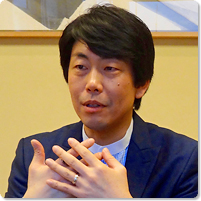
Tadashi Miroku
Born in 1968, Tadashi Miroku is a vocalist and director. He is a member of the Nikikai and the Japan Federation of Musicians.
Graduated from the graduate school of Chiba University. Graduated from the Department of Vocal Music of the Tokyo University of the Arts. In 1999, on an Italian government scholarship, he studied under Gloria Banditelli and Christina Miatello at the Conservatorio di Verona. From 2001 to 2003, Miroku was a lecturer at the Italian National Girolamo Frescobaldi Conservatorium. He studied directing at DAMS, University of Bologna. While performing actively as an opera vocalist in Japan and abroad, he is also active in directing opera productions such as L’oracolo in Messenia which was awarded the Best Opera of 2015 on “Ongaku no Tomo” magazine.
Since 2003, he has been in charge of planning and directing opera productions mounted in the small hall (Yokosuka Bayside Pocket) of the Yokosuka Arts Theatre, where he initiated the “Opera Delivery Service” project for the purpose of promoting the spread of opera, which began by presenting highlights from The Marriage of Figaro and The Barber of Seville and has expanded to presentations of early music performances of Henry Purcell’s Dido and Aeneasas well as a series easily enjoyed contemporary operas by Menotti that are rarely performed in Japan. Miroku has also launched a new series of opera performances using public courses and electone instrumental accompaniment that he calls “Digitalyrica” productions, including La traviata (2014) and Tosca (2016). For artistic achievements such as playing the messenger role in the opera Medea (2012), Miroku was awarded the New Artist Award (Music Division) of the Minister of Education, Culture, Sports, Science and Technology Fine Arts Awards in 2013 for the first time as a countertenor.
Interviewer: Masahiko Yokobori
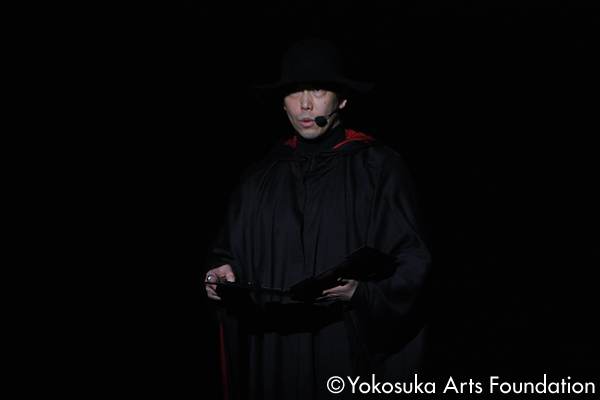
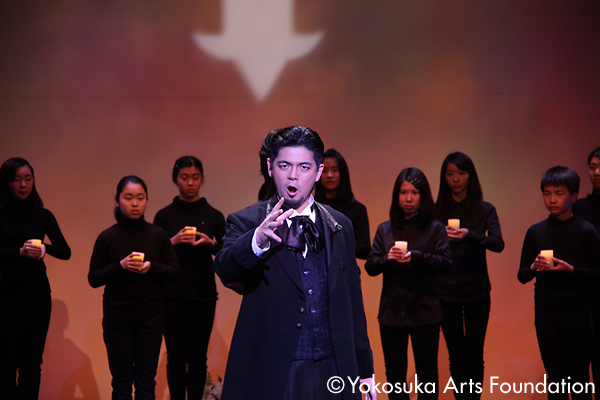
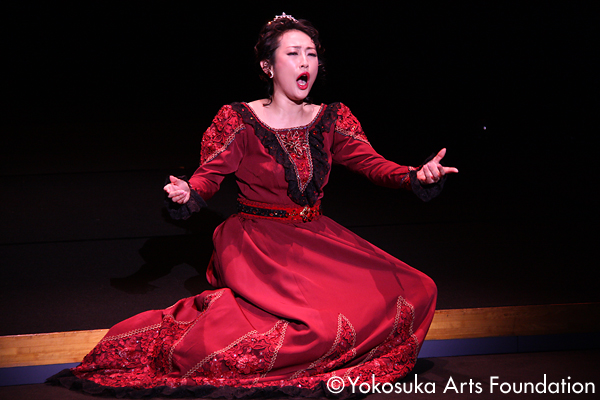
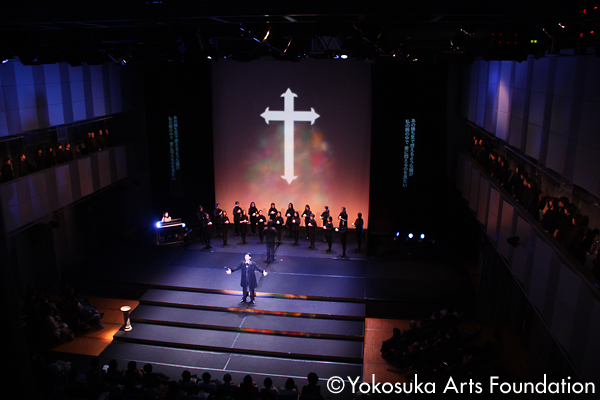
Yokosuka Art Theatre “Opera Delivery Series” XIV Tosca (Highlights)
(Mar. 13, 2016 at yokosuka art theatre – Yokosuka Bayside Poket)
planning and directing: Tadashi Miroku
(C) Yokosuka Arts Foundation
Related Tags

